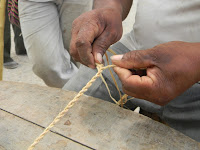 On Tuesday, September 24th, riot police (ESMAD) initiated unannounced forced removals (making them illegal) of local inhabitants impacted by the Quimbo Hydroelectric Project in Huila, Colombia. Members of the Association of Peoples Affected by the Quimbo Hydroelectric Project (ASOQUIMBO) and the collective Jaguos por el Territorio were injured as the removals commenced in the area of La Jagua.
On Tuesday, September 24th, riot police (ESMAD) initiated unannounced forced removals (making them illegal) of local inhabitants impacted by the Quimbo Hydroelectric Project in Huila, Colombia. Members of the Association of Peoples Affected by the Quimbo Hydroelectric Project (ASOQUIMBO) and the collective Jaguos por el Territorio were injured as the removals commenced in the area of La Jagua.  The removals started in the farms of La Virginia, Utica, Guipa, Guacas and the Olivos in the Municipality of Altamira with the detention of Alexander Naranjo and other locals being beaten and shot with “non-lethal” projectiles including a ASOQUIMBO member who uses a wheelchair. The illegal forced removals have continued into this week with the farms Palacio and Santiago in the Municipality of Garzón and starting Ocober 1st in Honda in the Municipality of Gigante. Over a hundred local residents have been living and working these lands for over five months since the liberation of these lands illegally bought by the construction company Emgeas-Endesa-Enel.
The removals started in the farms of La Virginia, Utica, Guipa, Guacas and the Olivos in the Municipality of Altamira with the detention of Alexander Naranjo and other locals being beaten and shot with “non-lethal” projectiles including a ASOQUIMBO member who uses a wheelchair. The illegal forced removals have continued into this week with the farms Palacio and Santiago in the Municipality of Garzón and starting Ocober 1st in Honda in the Municipality of Gigante. Over a hundred local residents have been living and working these lands for over five months since the liberation of these lands illegally bought by the construction company Emgeas-Endesa-Enel.
Prior to the removals, the peasants who have been growing corn, yuca, beans, squash and other crops on these vacant lands presented the Mayor of Altamira the legal status of their case. As the removals continue the police are also using heavy machinery to destroy the crops that local residents have been growing for their subsistence. Representative from the President´s Program of Human Rights, Fabiola Castillo Reina, who is the contact person for the community impacted by the Quimbo Hydroelectric Project, stated that she was incapable of doing anything to intervene and protect the rights of the impacted communities. Since then she has not answered her telephone or returned calls from the community members.
 The peasants who have worked these lands for generations for their subsistence were left unemployed and displaced by the company and the state that has consistently refused to recognize their rights. While some local inhabitants were included in the census of the impacted population, the majority have not been recognized as an impacted population.
The peasants who have worked these lands for generations for their subsistence were left unemployed and displaced by the company and the state that has consistently refused to recognize their rights. While some local inhabitants were included in the census of the impacted population, the majority have not been recognized as an impacted population.
On August 23, 2012, the Comptrollers Office of the Republic published a report that was sent to the Ministry of Environment, National Authority of Environmental Licenses, the Attorney General and the Ombudsman´s Office soliciting immediate action regarding the “census conducted by the company Emgesa of the impacted population of the Quimbo Hydroelectric Project”. The Comptroller´s Office found “major errors in the way the census was conducted and how the affected population was identified. Many individuals and families were left out of the census that meet the requisites to be included in the census and given indemnization”. The conclusion of the report was that the “census must be re-opened and corrected to include the excluded, impacted population”.
Nonetheless, the company continues to misinform the public and local media on their webiste, calling the local residents “invaders” and refusing to acknowledge their illegal acquistition of these lands. On June 14, 2011 the Ministry of Environment, through Resolution 1096, placed preventive measures on the Emgesa-Endesa-Enel for causing displacement and unemployment of the local population. Regardless, this same entity lifted this preventive measure based on reports from the company that were never verified by any agents of the Ministry of the Environment. On November 29, 2011, the Ministry issued Administrative Act 0123 that required the company to “allow the permanence of local inhabitants to continue working these lands,” requiring the company to “restitute local economic activity” as stated in the project´s environmental license.
Emgesa-Endesa-Enel shamelessly continues to mock the impacted communities and the entities of the State and continues to purchase lands, displace local residents and destroy the local economy and social fabric. The complicity of the Colombian State with the multinational corporations is evident in that the National Authority of Environmental licenses which is the institution in charge of maintaining the “legality” of resource extraction projects and that responsible companies comply with their project´s environmental licenses.
Actions of solidarity are being asked for by media, human rights organizations, and the general public in the denouncement of the trampling of the dignity and human rights of the people of the department of Huila in this latest episode where the Colombian State has shown itself to be an accomplice and at the service of the interests of the company Emgesa-Endesa-Enel.
Jennifer Chavarro Quino. 3147891727
Alexander Naranjo. 3204633118
Zoila María Ninco 3213243344
Don Francisco Castro 3134025817





































